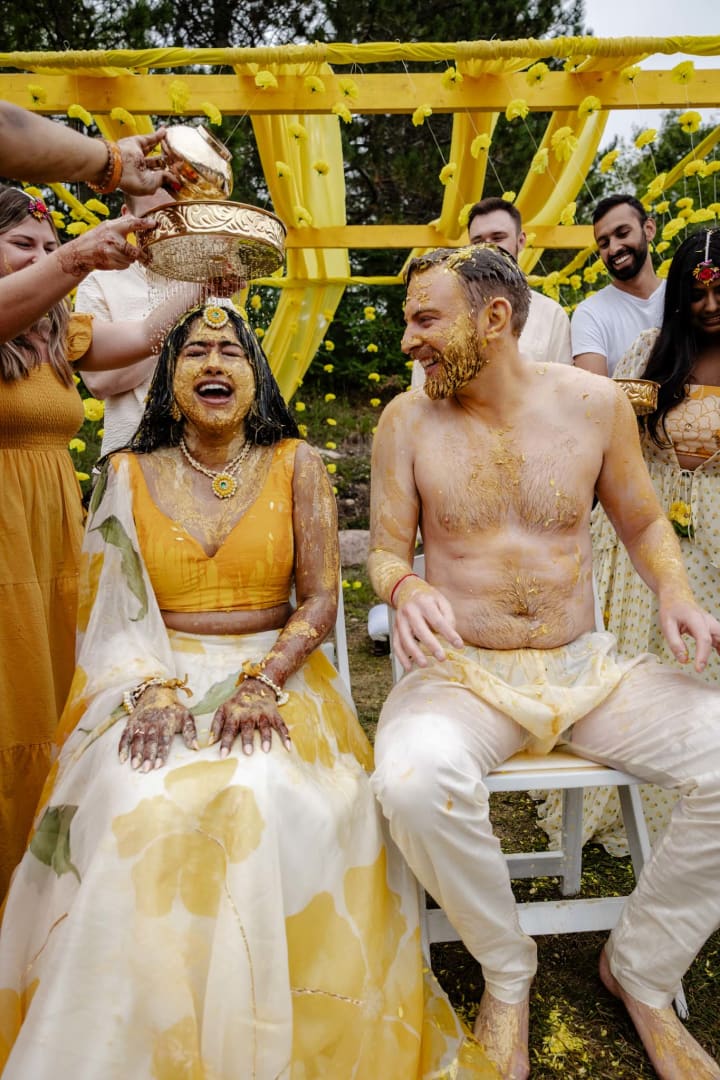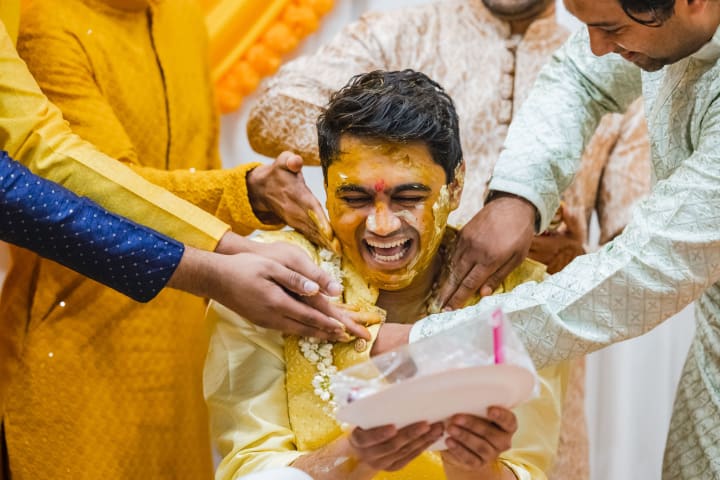HALDI CEREMONY INDIAN WEDDING TRADITION
INTRODUCTION TO HALDI

ceremony is particularly popular in Hindu weddings and is held a day or two before the main wedding day.The Haldi ceremony is performed to cleanse and purify the bride and groom before their wedding day, bringing a natural glow to their skin. It is also believed to ward off evil spirits and bring good luck. Everyone in the family and friends will get the opportunity to apply haldi to the couple.
HALDI PASTE
The Haldi paste is traditionally made by grinding turmeric, sandalwood, and other herbs into a thick, yellowish paste. Sometimes, other ingredients like rose water, milk, or gram flour (besan) are added to enhance the mixture. Yellow in turmeric is considered the colour of prosperity in Indian culture.
HALDI RITUAL IN INDIAN WEDDING
Family and friends take turns applying the Haldi paste to the bride and groom’s face, neck, arms, and feet. The ceremony is often accompanied by singing traditional songs, music, and laughter, creating a festive and joyous atmosphere. After the application of Haldi, the bride and groom are required to wait until the paste dries on their skin. They are then allowed to take a ritualistic bath or shower to cleanse themselves before the main wedding ceremony.The Haldi ceremony is not only a traditional ritual but also a time for family and friends to come together and celebrate the upcoming union. The vibrant colors, festive atmosphere, and meaningful customs make it a memorable event in the overall wedding festivities.

The Haldi ceremony, also known as Pithi or Ubtan, is an auspicious pre-wedding ritual in Indian weddings. It is believed to bless the bride and groom with good fortune and protect them from evil spirits. The ceremony symbolizes the beginning of a new journey and purifies the couple, preparing them for their marital life.
Rituals:
Preparation of Haldi Paste:
The main ingredient is Haldi (turmeric), which is mixed with other ingredients like sandalwood powder, rose water, milk, and sometimes yogurt or mustard oil to form a paste. Each family has its own recipe, often passed down through generations.
Application of Haldi:
The Haldi paste is applied to the bride and groom’s face, neck, hands, and feet by their family members and close friends. This is done in their respective homes or at a common venue, depending on the tradition followed by the families.
The ceremony usually starts with prayers and blessings from the elders.
Ritualistic Elements:The application of Haldi is done in a specific order, starting from the eldest family member to the youngest.
Traditional songs and music are often an integral part of the ceremony. Women from the family sing folk songs that celebrate love, marriage, and the joy of the upcoming wedding.
Significance of Turmeric:
Turmeric is known for its antiseptic and beautifying properties. It is believed to cleanse and purify the skin, giving the bride and groom a natural glow.
The yellow color of Haldi is also considered auspicious and symbolizes prosperity.
Fun and Festivities:
The atmosphere is lively and filled with laughter as family members and friends playfully apply Haldi to each other.
Sometimes, a mock fight ensues, with the couple trying to avoid getting too much Haldi on themselves, adding to the fun.
Post-Ceremony Rituals:
After the Haldi application, the couple is traditionally supposed to bathe and purify themselves.
The leftover Haldi paste is often shared among unmarried friends and relatives with the belief that it will bring them good luck and help them find suitable partners soon.
Cultural Variations:
The specifics of the Haldi ceremony can vary widely across different regions and communities in India:
In some cultures, the ceremony is held a day before the wedding, while in others, it might be a few days earlier.
The attire for the ceremony often includes traditional outfits like sarees for women and kurta-pajamas for men, usually in yellow to match the Haldi paste.
The ceremony might be accompanied by other rituals, such as the ‘Mehendi’ ceremony, where intricate henna designs are applied to the bride's hands and feet.
The Haldi ceremony is a cherished tradition that brings together families and friends in a joyful celebration, setting the tone for the upcoming wedding festivities.

About the Creator
creative captures
Creative Captures is Chicago indian wedding photographer and videographer. Award winning photographer and videographer specialized for luxury Indian and South Asian wedding
Enjoyed the story? Support the Creator.
Subscribe for free to receive all their stories in your feed. You could also pledge your support or give them a one-off tip, letting them know you appreciate their work.






Comments
There are no comments for this story
Be the first to respond and start the conversation.